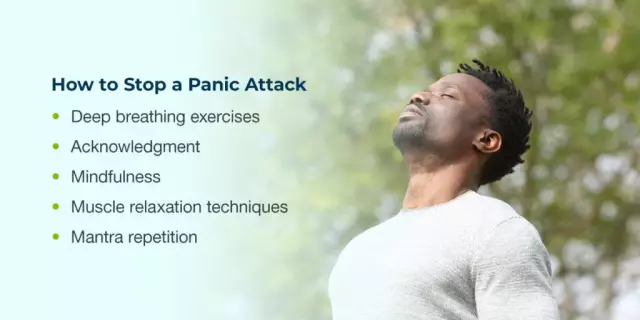- Author Rachel Wainwright [email protected].
- Public 2023-12-15 07:39.
- Last modified 2025-11-02 20:14.
Panic attack: 6 ways to control
The phenomenon of panic attack has been known for a long time, but its causes are not fully understood. It has been established that more than 30% of people at least once in their life become victims of a very unpleasant phenomenon: for no reason at all, they have a feeling of horror, accompanied by a rapid heartbeat, trembling and chills, or sudden fever, increased sweating, shortness of breath, dizziness, nausea. An attack is characterized by a partial loss of connection with reality: a person experiences fear of death, although there is really no danger to his life. Symptoms appear suddenly and persist for 15 to 20 minutes. In some patients, such attacks are repeated several times, worsening the general state of health, complicating the course of chronic ailments and seriously reducing the quality of life.
However, experts have developed techniques to help control the state of a panic attack and minimize its unpleasant manifestations.
Calm breathing
The rapid breathing rhythm during a panic attack appears instinctively - as a reaction to fear and signs of suffocation. In this case, hyperventilation of the lungs occurs. When combined with high levels of carbon dioxide in the blood, it aggravates the discomfort and aggravates painful symptoms. To stabilize the situation, you need to consistently:
- Inhale air through your nose for 5 seconds.
- Hold your breath for 1-2 seconds.
- Exhale through your half-open mouth for 4 seconds.
- Wait 2 seconds before inhaling again.
- Repeat the cycle until slow breathing becomes automatic.

Source: depositphotos.com
Muscle relaxation
With a panic attack, it is very important to achieve the removal of muscle hypertonicity. For this, a technique of alternating relaxation and tension of various muscle groups is recommended. Usually, exercises begin with the lower extremities, gradually moving up. Muscle tension should be carried out on inhalation, and muscle relaxation should be carried out on exhalation.

Source: depositphotos.com
Thought control
Patients who have panic attacks on a regular basis note that an attack can be triggered even by the thought that it is possible and by the fear of its occurrence. It is very important for such patients to control their mood in order not to allow the process to become an avalanche. Establishing a calm mindset with an adequate assessment of the danger of a real situation is called attention technique or cognitive-behavioral therapy. Patients cannot always learn to control their thoughts on their own. Many of them require individual counseling or group sessions. This is especially true for people with the so-called catastrophic type of thinking: they, as a rule, are not able to adequately assess the situation without the help of a specialist.

Source: depositphotos.com
Physical activity
People prone to panic attacks, out of fear of another attack, often tend to make as few unnecessary movements as possible and leave the house less often. This way of life is very harmful. Patients should not give up physical activity: walking in the fresh air, light sports, swimming not only do not provoke the appearance of painful symptoms, but also activate the production of endorphins, which help to cope with stress, improve mood and overall well-being.

Source: depositphotos.com
Planning
Panic attacks are often triggered by standard stressful situations: for example, attacks occur in students who are overly anxious before exams, in people who are afraid of flying. These patients are usually aware of the specifics of their reactions, but in the absence of a competent approach, such knowledge only exacerbates the problem. The most correct thing is to try to prepare for an unpleasant event (if there is no way to avoid it). A panic attack can be prevented by sensibly considering the situation and adequately assessing the risks. It is also useful to ask for help from relatives or friends, informing them in advance about your characteristics, to warn about possible painful manifestations and ways to minimize their consequences.

Source: depositphotos.com
Balanced diet
Maintaining optimal blood sugar levels is very important for those suffering from panic attacks. Therefore, they are shown regular meals with breaks between meals for no more than 4 hours. The diet should be balanced in essential nutrients and maximally saturated with vitamins. Patients should not drink alcohol. It is also necessary to limit the use of black coffee and strong tea - caffeine, which these drinks are rich in, tones the body, which can provoke an attack.

Source: depositphotos.com
A panic attack in itself is not life-threatening, but if repeated regularly, it can cause the development of cardiovascular pathologies or serious neurological disorders. In case of repeated occurrence of such conditions, the patient should consult a specialist in order to start treatment in a timely manner and not to start the disease.
YouTube video related to the article:

Maria Kulkes Medical journalist About the author
Education: First Moscow State Medical University named after I. M. Sechenov, specialty "General Medicine".
Found a mistake in the text? Select it and press Ctrl + Enter.






